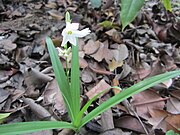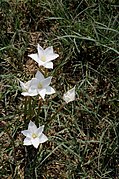Zephyranthes chlorosolen
| Zephyranthes chlorosolen | |
|---|---|

| |
| Flower | |

| |
| 1836 botanical illustration | |
| Scientific classification | |
| Kingdom: | Plantae |
| Clade: | Tracheophytes |
| Clade: | Angiosperms |
| Clade: | Monocots |
| Order: | Asparagales |
| Family: | Amaryllidaceae |
| Subfamily: | Amaryllidoideae |
| Genus: | Zephyranthes |
| Species: | Z. chlorosolen
|
| Binomial name | |
| Zephyranthes chlorosolen | |
| Synonyms[1] | |
|
List
| |
Zephyranthes chlorosolen, known by a number of common names including Drummond's rain‑lily, evening rain‑lily, evening star rain lily (names it shares with Zephyranthes drummondii), Brazos rain‑lily, Texas rainlily, and cebolleta, is a species of flowering plant in the family Amaryllidaceae.[2][3] It is found from Kansas to Mexico, and has been introduced to southern Brazil. A geophytic perennial typically 18 to 35 cm (7 to 14 in) tall, its lone flower opens in the evening and lasts only a few days.
Description[edit]
It is a geophytic perennial herb that typically grows between 18 and 35 cm (7.1 and 13.8 in) tall.[2] The leaf blades are dull green, and are up to 5 mm wide. The spathe is 3 to 5.7 cm (1.2 to 2.2 in). The flowers are erect; the salverform perianth is 7.3 to 16 cm (2.9 to 6.3 in) long, and is white, sometimes tinged or veined with pink. The perianth tube is 7 to 13 cm (2.8 to 5.1 in), and is primarily white, sometimes with pale green proximally. The tepals are rarely reflexed. The stamens are fasciculate, and appear equal. The filaments are 0.2 to 0.5 mm, and are subulate. The anthers are 4 to 9 mm. The style is longer than the perianth tube. The stigma is capitate, and is among or very near the anthers. The pedicel is usually absent, but is rarely 0.1 cm.[4]
Distribution[edit]
It is found in the United States (Texas, Oklahoma, Mississippi, Louisiana, Kansas, Arkansas, Alabama, New Mexico), Mexico, and southern Brazil from elevations of 0 to 2400 meters from sea level.[5][1]
Photo Gallery[edit]
References[edit]
- ^ a b "Zephyranthes chlorosolen (Herb.) D.Dietr". Plants of the World Online. Royal Botanic Gardens, Kew. Retrieved 19 April 2023.
- ^ a b Gibson, A. C. "Zephyranthes chlorosolen (Amaryllidaceae)". Vascular Plants of Williamson County. University of Texas at Austin. Retrieved 19 April 2023.
- ^ "Zephyranthes chlorosolen". Plants of Louisiana. United States Geological Survey. Retrieved 19 April 2023.
- ^ "Zephyranthes chlorosolen - FNA". floranorthamerica.org. Retrieved 2023-08-02.
- ^ "Cooperia chlorosolen.png (1052x642)". The Biota of North America Program. Archived from the original on January 14, 2023. Retrieved August 2, 2023.



